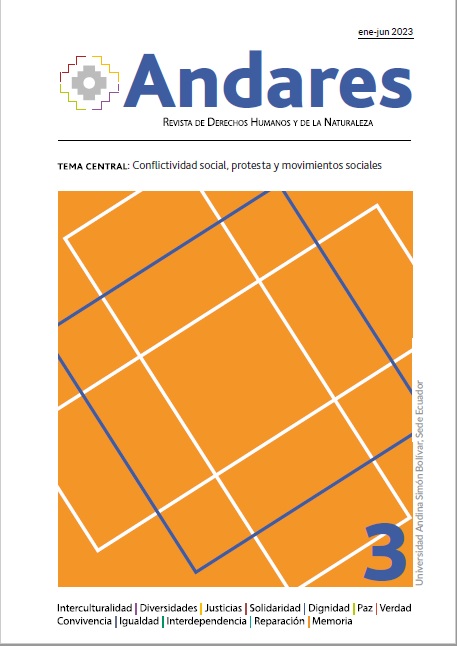Human Rights Reinforced: The Protection of People with Disabilities under the Inclusion Paradigm
DOI:
https://doi.org/10.32719/29536782.2023.1.4Keywords:
human rights of people with disabilities, inclusion, medical model of disability, social model of disability, strengthened protection of human rights, pro personae principleAbstract
This research aims to analyze the current paradigm of the human rights of people with disabilities to identify some legal instruments and their performance in defense of these rights. This topic has gained relevance globally and locally whenever people with disabilities are a vulnerable group that, throughout human history, has had to remove several barriers to exercising their human rights. For it, the research motranscends the medical paradigm, seeking to move towards the social approach in the analysis of disability, but mainly aims to abandon the conceptual, theoretical framework of equality and drive to that of inclusion; and analyze its implementation in social reality. This goal is the principal academic contribution of this study. To develop the analysis, the methodology of this work is developed under the modality of an exhibition article, in which two phases are distinguished: the first chapter consists of a documentary study on disability and the various treaties, legislations, and figures laws that protect the rights of people in such situation. In the second chapter, these points are analyzed, emphasizing concepts such as reinforced protection and the pro personae criterion to identify whether these instruments ensure that the inclusion and defense of the rights of people with disabilities are a social reality or if they only remain in the attempt. Justice access is essential for human rights exercise, without obstacles preventing people with disabilities from accessing justice under good conditions. These obstacles imply a restriction on the entire practice of their legal capacity. According to this, the state must guarantee access to social justice, democratic governance, the rule of law, and the inclusion of all people; therefore, in this article, legal figures contribute to protecting the human rights of people with disabilities are addressed.
Downloads
References
Barbosa, Samuel, Felipe Villegas y Jonathan Beltrán. “El modelo médico como generador de discapacidad”. Revista Latinoamericana de Bioética 37, n.° 2 (2019): 111-22. https://doi.org/10.18359/rlbi.4303.
Castañeda, Mireya. El principio pro persona: Experiencia y expectativas. Ciudad de México: CNDH, 2014.
Comisión de Derechos Humanos del Distrito Federal. Acceso a la justicia y derechos humanos. Ciudad de México: Comisión de Derechos Humanos del Distrito Federal, 2011.
Hernández, Armando. “Igualdad, libertad y justicia”. ContraRéplica. 16 de noviembre de 2020. https://bit.ly/3HmNc2e.
—. “Protección reforzada de los DH de las personas con discapacidad”. ContraRéplica. 4 de julio de 2022. https://bit.ly/3ndmUbT.
México. Constitución Política de los Estados Unidos Mexicanos. Diario Oficial de la Federación. 18 de noviembre de 2022 (última reforma).
México CNDH. La Convención sobre los Derechos de las Personas con Discapacidad y su Protocolo Facultativo. Ciudad de México: CNDH, 2020.
México INEGI. “Estadísticas a propósito del día internacional de la eliminación de la discriminación racial (21 de marzo)”. Comunicado de prensa n.° 133/20. INEGI. 19 de marzo de 2020. https://bit.ly/3LBk7l9.
México Secretaría de Desarrollo Social. Diagnóstico sobre la situación de las personas con discapacidad en México. Ciudad de México: Gobierno de México, 2020.
Núñez, Constanza. Una aproximación conceptual al principio pro persona desde la interpretación y argumentación jurídica. Madrid: Seminario Gregorio Peces-Barba, 2017.
Quinn, Gerard, y Theresia Degener. Derechos humanos y discapacidad: Uso actual y posibilidades futuras de los instrumentos de derechos humanos de las Naciones Unidas en el contexto de la discapacidad. Nueva York: Organización del Alto Comisionado de los Derechos Humanos, 2002.
Sarel, Brenda. “Las personas con discapacidad en México: Una mirada a la realidad”. Derechos Fundamentales a Debate 16 (2021): 37-55. https://bit.ly/44iXxGm.
Velarde, Valentina. “Los modelos de la discapacidad: Un recorrido histórico”. Revista Empresa y Humanismo 15, n.° 1 (2016): 115-36. https://doi.org/10.15581/015.15.4179.
Vergara, Rafael. “Análisis histórico conceptual de la política desde la transdisciplinariedad”. Justicia 33 (2018): 170-99. https://bit.ly/3LE2Cl9.
Victoria, Jorge. “El modelo social de la discapacidad: Una cuestión de derechos humanos”. Revista de Derecho UNED 12 (2013): 817-33. https://bit.ly/424uPqB.






